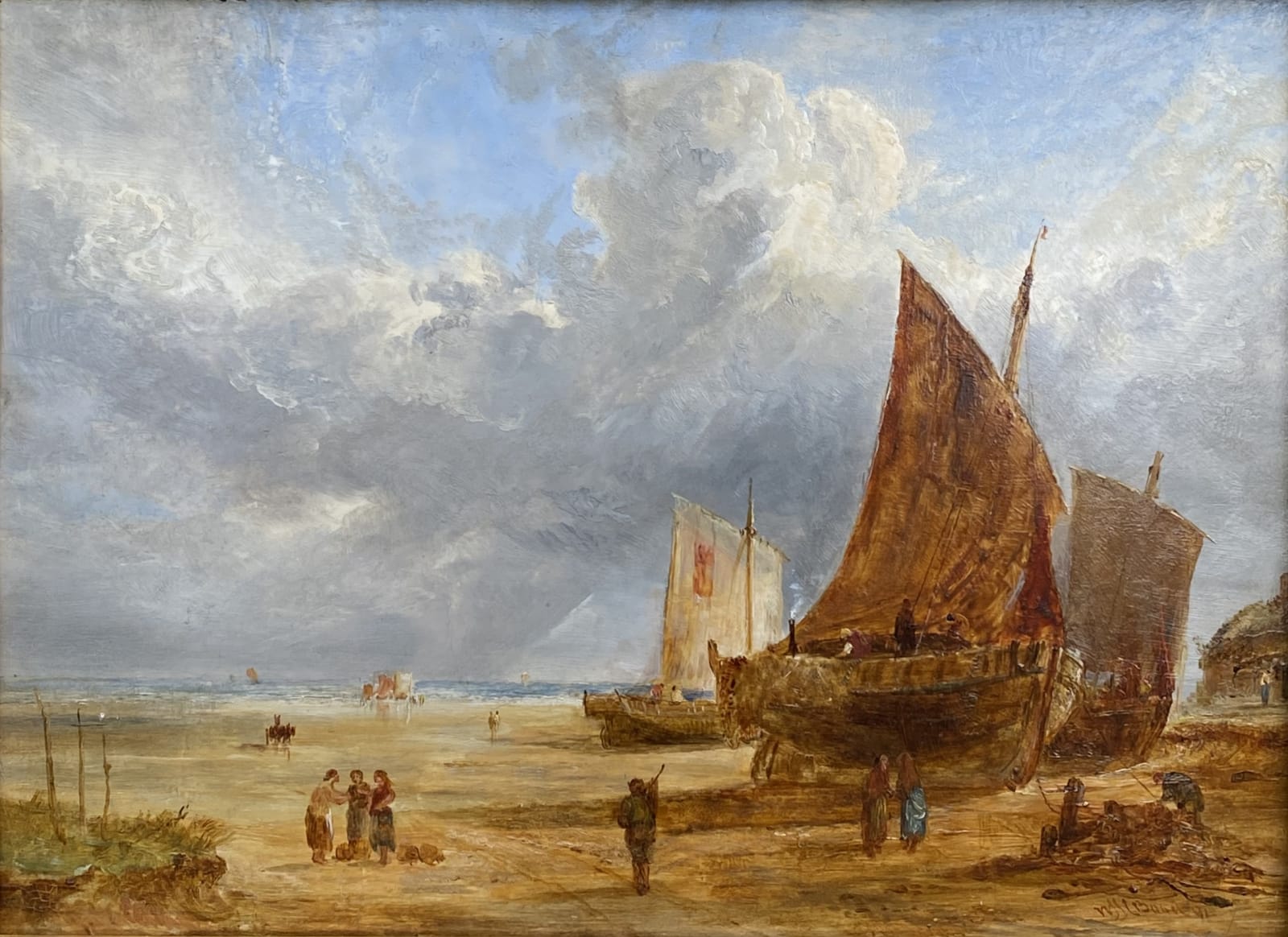William Joseph Julius Caesar Bond English, 1833-1926
On the Beach
Oil on panel
Size without frame 12 x 17 ins (unframed)
William Joseph Bond was born in Knotty Ash, Liverpool, on 22 August 1833, the son of William Bond, who kept a private school, and his wife, Susannah. He received his early education at home, and was then sent for a few years to Stonyhurst, the Jesuit college in the Ribble Valley. When his father gave up his school, he was apprenticed to Thomas Griffiths, a miniature painter, picture dealer and restorer, in Liverpool, ‘to learn the whole trade and business of a picture restorer and cleaner’. Once he began ‘to sketch a little out of doors’, his resulting work was seen by the Scottish Liverpool based tobacco merchant and collector, John Miller, who ‘advised me to follow it up entirely and I have done so ever since’. (These reminiscences, written by Bond in 1883, are taken from Mary Bennett (ed), Merseyside Painters, People & Places: Catalogue of Oil Paintings, Liverpool: Walker Art Gallery, 1978, vol 1, page 43.)
Coming under the influence of the Pre-Raphaelites during the 1850s, Bond began to exhibit at the Liverpool Academy, and was elected an associate in 1856, and a full member in 1859. He also contributed to exhibitions in London, at the Society of British Artists (from 1857) and, more occasionally, at the Royal Academy and the British Institution, though his work was bought mainly by northern patrons. It seems that he chose to add ‘Julius Caesar’ to his name, which led to his distinctive signature with its many initials and, in turn, gave rise to his nickname, ‘Alphabet Bond’.
By 1860, Bond had left Liverpool, and was living in Caernarvonshire. As his career developed, he became increasingly influenced by the work of J M W Turner, and applied his fresh, loose handling to seascapes as well as landscapes. He made a number of sketching tours to parts of England and Wales, travelling as far as Cornwall and Norfolk, and also visiting the Low Countries on at least one occasion before the mid 1870s.
The writer, Henry Currie Marillier, described him as ‘the essence of sympathetic good-nature, popular with children, full of humour, and a keen but quiet judge of character in others’ (The Liverpool School of Painters, London: J Murray, 1904 page 77).
Still painting and sailing into his late seventies, Bond lived at addresses in Massey Park, Wallasey, on the Wirral, Cheshire, where he was looked after by his elder, unmarried daughter, Margaret. He died in Freshfield, Formby, to the north of Liverpool, on 29 March 1926, at the age of 92.
He is represented in numerous public collections, including the Walker Art Gallery and the Williamson Art Gallery and Museum; and Bangor University.
Coming under the influence of the Pre-Raphaelites during the 1850s, Bond began to exhibit at the Liverpool Academy, and was elected an associate in 1856, and a full member in 1859. He also contributed to exhibitions in London, at the Society of British Artists (from 1857) and, more occasionally, at the Royal Academy and the British Institution, though his work was bought mainly by northern patrons. It seems that he chose to add ‘Julius Caesar’ to his name, which led to his distinctive signature with its many initials and, in turn, gave rise to his nickname, ‘Alphabet Bond’.
By 1860, Bond had left Liverpool, and was living in Caernarvonshire. As his career developed, he became increasingly influenced by the work of J M W Turner, and applied his fresh, loose handling to seascapes as well as landscapes. He made a number of sketching tours to parts of England and Wales, travelling as far as Cornwall and Norfolk, and also visiting the Low Countries on at least one occasion before the mid 1870s.
The writer, Henry Currie Marillier, described him as ‘the essence of sympathetic good-nature, popular with children, full of humour, and a keen but quiet judge of character in others’ (The Liverpool School of Painters, London: J Murray, 1904 page 77).
Still painting and sailing into his late seventies, Bond lived at addresses in Massey Park, Wallasey, on the Wirral, Cheshire, where he was looked after by his elder, unmarried daughter, Margaret. He died in Freshfield, Formby, to the north of Liverpool, on 29 March 1926, at the age of 92.
He is represented in numerous public collections, including the Walker Art Gallery and the Williamson Art Gallery and Museum; and Bangor University.
Join our mailing list
McEwan Gallery Newsletter
* denotes required fields
We will process the personal data you have supplied in accordance with our privacy policy (available on request). You can unsubscribe or change your preferences at any time by clicking the link in our emails.
